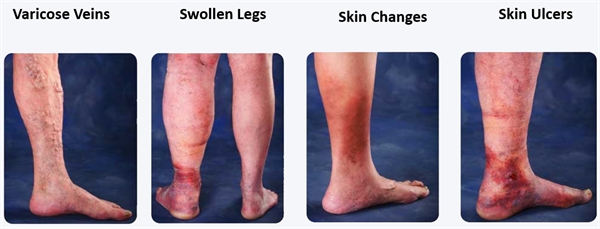Varicose and Spider Veins
What are varicose veins?
Varicose veins, large dark-colored veins visible below the surface of the skin, occur from an increase in pressure within the vein. They are the result of underlying venous disease and a sign of venous insufficiency. Venous insufficiencies range from mild forms that may be largely cosmetic and cause slight discomfort, to more severe forms that can cause venous ulcers or more serious health concerns.
What are the symptoms of varicose veins?
Symptoms of varicose veins include:
- Bulging or stretching superficial leg veins
- Aching or throbbing
- Heavy, tired, itching or restless legs
If left untreated, venous insufficiency caused by varicose veins can lead to swelling, dark discoloration of the skin, and ulcers on the legs. The Venefit Closure Procedure is a safe process for treating varicose veins.
What causes varicose veins?
In normal veins, blood flows to the heart, and valves prevent the blood from flowing backward. With varicose veins, the valves do not seal fully and allow blood to leak downward. Blood pools in the vein, increasing venous pressure and weakening the vein wall. The result is leg swelling and superficial vein distortion typical of this condition.
In some cases, varicose veins are a precursor of a potentially dangerous condition known as Deep Vein Thrombosis (DVT). Only a qualified medical professional such as Dr. Vasquez can properly evaluate the venous disorder for each individual patient.
Many factors, such as age, gender, genetics, weight, and lifestyle can contribute to the development of venous disorders and varicose veins. Other common causes include certain hormones, such as progesterone, genetic deficiencies, pregnancy, obesity, hormone replacement therapy, female oral contraceptives, and occupations that require long periods of standing.
Can I prevent varicose veins?
Unfortunately varicose veins cannot be completely prevented; however, there are many ways to improve vein health. Physical activity such as walking, cycling, jogging and swimming are great ways to improve circulation, by pumping blood up the leg against gravity. Graduated compression hose can also help improve circulation by preventing blood from pooling in the leg veins.
Treatment for this conditions:
What are spider veins?
Spider veins (also known as spider telangiectasias) appear as thin veins visible below the surface of the skin. As their name suggests, they usually appear in a pattern similar to a spider web. They are most common on the face and legs and can be red or blue in color. Spider veins are much smaller than varicose veins and do not appear enlarged or “knotted” as with more serious venous disorders.
Spider veins are not usually a serious health concern, but cosmetically, their appearance is a concern for many patients. Treatments to reduce noticeable spider veins on the legs or facial redness are common. However, because spider veins can be an indication of a more serious venous problem, a thorough evaluation by a medical professional is advised.



